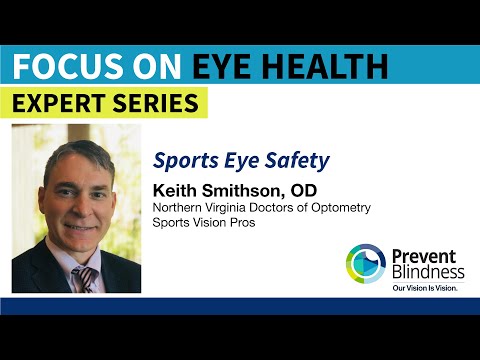The relatively new sport of pickleball is also increasing the number of eye injuries. According to the American Academy of Ophthalmology (AAO), injuries may occur from being struck by the ball or by the paddle. The AAO states “the risk of eye injury is higher in doubles games because two players are always close to the net and have less time to duck and avoid a fast-flying ball.”
Types of sports-related eye injuries include blunt trauma, including retina tears or detachment, penetrating injuries, corneal scratches and abrasions. Some eye infections are contracted through water sports, with contact lens wearers at higher risk.
Prevent Blindness recommends that athletes wear eye guards when participating in sports as prescription glasses, sunglasses and even occupational safety glasses do not provide adequate protection. Athletes, or parents of children participating in sports, should always consult an eye care professional to determine the best kind of eye protection for their sport and medical needs.
Prevent Blindness recommends the following guidelines:
- Monocular athletes (a person with only one eye that sees well), should ask their eye doctor what sports they can play safely. Monocular athletes should always wear sports eye guards.
- When purchasing eye guards with lenses, make sure the lenses either stay in place or pop outward in the event of an accident. Lenses that pop in against the eyes can be very dangerous.
- Polycarbonate eye guards are the most impact resistant. Polycarbonate lenses are also thinner and lighter than plastic, shatterproof, and provide UV protection. For sports use, polycarbonate lenses must be used with protectors that meet or exceed the requirements of ASTM (American Society for Testing and Materials) International, a global standards development organization.
- Each sport has a specific ASTM standard, so check the package and/or protector to make sure the appropriate ASTM standard designation for the sport is on the product, before buying it. Do not buy the product if there is no ASTM code provided.
- Look for eye guards that are certified by an authorized certification organization such as the Safety Equipment Institute (SEI) or independently tested by an accredited laboratory that provides independent verified evidence of protection and performance. Do not buy products labeled as ‘ASTM Certified’ as ASTM does not certify products.
Prevent Blindness offers the new Focus on Eye Health Expert Series episode, “Sports Eye Safety,” with sports vision specialist Keith Smithson, OD, of Northern Virginia Doctors of Optometry, and Sports Vision Pros. Sports eye safety fact sheets, shareable graphics for social media, and a dedicated webpage are available.
“Most sports-related eye injuries can be avoided by simply wearing the proper eye protection” said Jeff Todd, president and CEO at Prevent Blindness. “By working with your eye care professional, you can stay in the game with healthy eyes today and for years to come.”
For more information on sports eye safety and injury prevention, please visit Prevent Blindness at PreventBlindness.org/sports-eye-safety.
About Prevent Blindness
Founded in 1908, Prevent Blindness is the nation’s leading volunteer eye health and safety organization dedicated to fighting blindness and saving sight. Focused on promoting a continuum of vision care, Prevent Blindness touches the lives of millions of people each year through public and professional education, advocacy, certified vision screening and training, community and patient service programs and research. These services are made possible through the generous support of the American public. Together with a network of affiliates, Prevent Blindness is committed to eliminating preventable blindness in America. For more information, visit us at PreventBlindness.org, and follow us on Facebook, X, Instagram, Threads, LinkedIn, TikTok and YouTube.
Media Contact
Sarah Hecker, Prevent Blindness, 3123636035, [email protected], PreventBlindness.org
SOURCE Prevent Blindness


